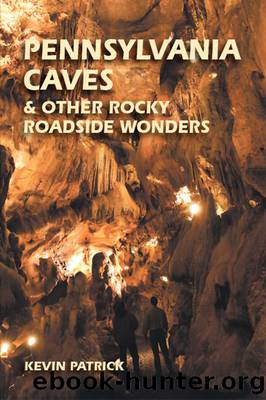Pennsylvania Caves & Other Rocky Roadside Wonders by Kevin Patrick

Author:Kevin Patrick
Language: eng
Format: epub
ISBN: 9780811745550
Publisher: Stackpole Books
Published: 2013-05-17T00:00:00+00:00
* * *
The Wertzâs half-million-dollar investment included a stone cottage house at the base of the hill that also functioned as the first ticket office. A second ticket office and gift shop was built into the side of the cave after the first year of operation. In the past, some visitors had been discouraged from going into the cave because of the need to walk up the steep hill. With the new setup, such visitors had already climbed the hill to reach the ticket office and so were less deterred.
Hubby hired fifty workmen to dig out clay from the passages, level the floor, lay down crushed stone walkways, pour concrete steps, and string wires for electric lights. Like Hipple, the cave terminated in a Writing Room with smooth walls etched with the names of previous visitors, the oldest dating to 1816. Hubby was not convinced that this was the end of the cave, surmising that the water that formed the passage had to have drained somewhere. After digging through the clay floor of the Writing Room, Hubby and Lenore found a hole at the bottom of the wall that led to an entirely new section. Workmen blasted a 14-foot tunnel through the limestone, doubling the length of the cave.
The new section was widely promoted as the Enchanted Caverns and included a number of enticing magical references like the Giantâs Hall, which was split by a slab of breakdown aptly named the Giantâs Shield, beyond which hid the Jewel Room with its Lily Pad Pool. There was even a Musical Rock, a thin, pointed projection that to this day is still struck with a mallet to produce a vibrating tone. The pride of the new section, however, was the Frozen Niagara, a massive wall of flowstone reputed to be the largest calcite formation in Pennsylvania. To emphasize its bulk, pictures of it were published showing people at slightly less than normal scale. A liquid latex cast of it was made in 1939 for the cave exhibit at Pittsburghâs Carnegie Museum. A black patch of rubber was left behind as evidence for the tourists to see.
As stunning as the new discoveries were, they paled in comparison to another find that would change the course of Wertzâs promotion and fix the identity of the cave. In leveling the floor of the Entrance Hall, workers started turning up Indian artifacts and fragments of bone belonging to both animals and humans. Work was halted while archeologists unearthed dozens of relics and skeletal remains. These were examined by Neil M. Judd, curator of American Archeology at the National Museum in Washington, and the museumâs paleontologist, Dr. Gerrit S. Miller. Specimens were also sent to Boyd P. Rothrock, director of the State Museum in Harrisburg. The total cache of arrowheads, points, pipes, beads, blades, bracelets, and other relics was reported to be more than four hundred items belonging to Iroquois and Algonquin people dating back four centuries.
Built in 1930, Indian Cavernsâs gift shop was originally designed to have the appearance of a Southwestern Indian cliff dwelling.
Download
This site does not store any files on its server. We only index and link to content provided by other sites. Please contact the content providers to delete copyright contents if any and email us, we'll remove relevant links or contents immediately.
Giovanni's Room by James Baldwin(7199)
The Plant Paradox by Dr. Steven R. Gundry M.D(2549)
The Stranger in the Woods by Michael Finkel(2458)
Miami by Joan Didion(2327)
Wild: From Lost to Found on the Pacific Crest Trail by Cheryl Strayed(2215)
INTO THE WILD by Jon Krakauer(2158)
DK Eyewitness Top 10 Travel Guides Orlando by DK(2131)
Trail Magic by Trevelyan Quest Edwards & Hazel Edwards(2127)
Vacationland by John Hodgman(2093)
The Twilight Saga Collection by Stephenie Meyer(2088)
Nomadland by Jessica Bruder(2016)
Birds of the Pacific Northwest by Shewey John; Blount Tim;(1926)
The Last Flight by Julie Clark(1911)
Portland: Including the Coast, Mounts Hood and St. Helens, and the Santiam River by Paul Gerald(1885)
On Trails by Robert Moor(1854)
Deep South by Paul Theroux(1787)
Blue Highways by William Least Heat-Moon(1723)
Trees and Shrubs of the Pacific Northwest by Mark Turner(1682)
1,000 Places to See in the United States and Canada Before You Die (1,000 Places to See in the United States & Canada Before You) by Patricia Schultz(1609)
